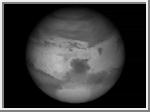|
COMETS EARTH JUPITER KUIPER BELT MARS MERCURY METEORITES NEPTUNE OORT CLOUD PLUTO SATURN SOLAR SYSTEM SPACE SUN URANUS VENUS ORDER PRINTS
PHOTO CATEGORIES SCIENCEVIEWS AMERICAN INDIAN AMPHIBIANS BIRDS BUGS FINE ART FOSSILS THE ISLANDS HISTORICAL PHOTOS MAMMALS OTHER PARKS PLANTS RELIGIOUS REPTILES SCIENCEVIEWS PRINTS
|
Related Document
Download Options
This movie was created by combining the eight MGS/MOC MOI-22 day approach images into a map of Mars, and then digitally reprojecting that map onto a sphere. This is the same process used by the Hubble Space Telescope team in making its rotation movie from HST data. The HST data were acquired when Mars was viewed more or less "face on," whereas MGS/MOC viewed the planet at half-phase. Thus, each of the eight MOC images required processing to remove the overall shading (the photometric function). Software provided by the Hubble Space Telescope Mars Monitoring team was used for this purpose. This software was also used to create a map projection of each image. These were then mosaiced together to create a map of the visible part of the planet (areas south of 66.4°S were not ever seen). Owing to foreshortening in the polar regions, some cosmetic processing was needed in areas south of about 35°S as well. Once the final map was created, a limited amount of enhancement was applied to sharpen features, and the resulting image was "mapped" onto a sphere using computer graphic software. A camera within this software was place at a relative distance and appropriate magnification to recreate the view seen from MGS, and an illumination source was set at the right location to simulate the sun. A set of test images were then created to compare with the original images. When the simulation recreated the input images, the rotation of the planet was simulated, and the camera position moved to observe the planet "face-on." |
